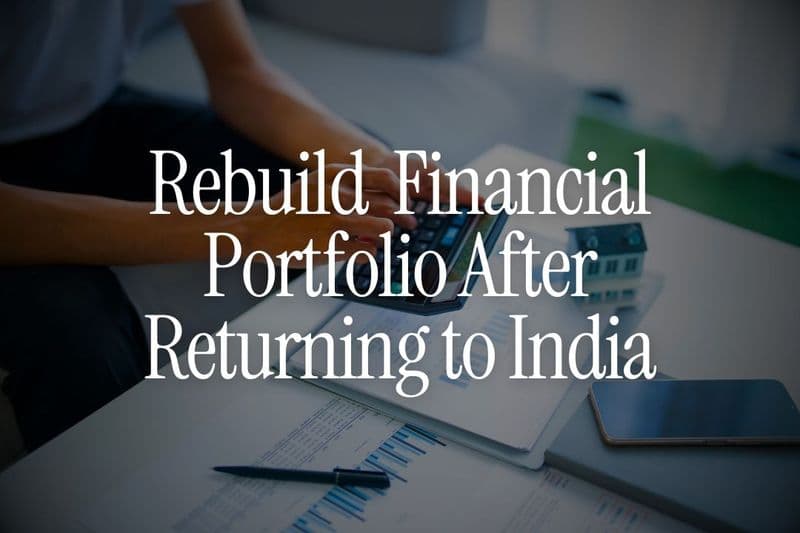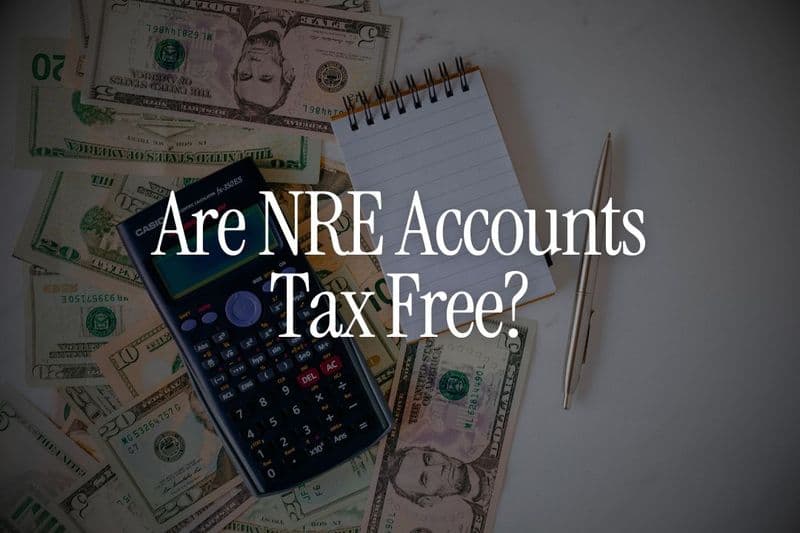
You've just received your quarterly bonus in Dubai.
₹50 lakh sitting in your NRE savings account earning 2.5% per year.
Your colleague tells you he's making 12% from mutual funds. Another friend swears by GIFT City USD FDs. Your WhatsApp group is debating whether FDs are "dead money."
Who's actually right?
After 12 years of advising NRIs, we can tell you this: there is no single "best" option. The right choice depends on three simple questions most people never ask properly.
We will give you the exact framework we use with clients who manage anywhere from ₹10 lakh to ₹5 crore across borders.
The Three Questions That Matter
Before you read another comparison table, answer these honestly:
1. When do you need this money?
- Within 1 year? You have one set of options.
- In 3-5 years? Different game.
- Only after 10+ years? Completely different strategy.
2. Can you stomach a 30% drop?
- If your ₹10 lakh became ₹7 lakh tomorrow, would you panic-sell?
- Or would you stay invested?
- Be brutally honest here.
3. What are you actually trying to achieve?
- Emergency fund?
- Down payment for property in 3 years?
- Retirement corpus?
- Kids' education in 8 years?
Your answers to these three questions matter more than interest rates. Here's why.
Understanding Your Three Options (What They Actually Are)
Savings Accounts: Your Financial First-Aid Kit
Think of savings accounts as the money you'd need if you lost your job tomorrow.
NRE Savings Account:
- Current rate: 2.5% per year (SBI, HDFC, ICICI)
- Fully repatriable (send money back anytime)
- Tax-free interest in India
- Zero currency risk (held in rupees)
GIFT City USD Savings Account:
- Current rate: 3.5-4.5% per year (ICICI GIFT City, Yes Bank GIFT City)
- Held in US dollars
- Tax-free interest in India and UAE
- Protects against rupee devaluation
Use Belong's NRI FD comparison tool to see current rates across all major banks.
Best for:
- Emergency fund (6-12 months of expenses)
- Money needed within 6 months
- Peace of mind
Not suitable for:
- Long-term wealth building
- Beating inflation
- Retirement planning
Fixed Deposits: The Middle Ground
FDs lock your money for a fixed period. You get guaranteed returns. Break it early, you lose interest.
NRE Fixed Deposits:
- 1-year tenure: 6.5-7% (HDFC, ICICI, SBI)
- 3-year tenure: 6.75-7.25%
- Tax-free in India
- Held in Indian rupees
- Fully repatriable
FCNR Deposits:
- Held in foreign currency (USD, EUR, GBP)
- 1-year tenure: 3.5-5%
- Protects from rupee depreciation
- Tax-free in India
Also Read - Banks Offering the Highest FCNR Deposit Rates
GIFT City USD Fixed Deposits:
- 1-year tenure: 4.5-6%
- 3-year tenure: 4.10.6%
- Tax-free in India and UAE
- No TDS deduction
- Fully repatriable from 3 months
Check the latest GIFT City FD rates compared with traditional NRE FDs.
Best for:
- Known expenses in 1-5 years
- Conservative investors
- Guaranteed returns with zero risk
- Parking large sums temporarily
Not suitable for:
- Emergency funds (penalties for early withdrawal)
- Very long-term goals (inflation eats returns)
- Wealth building beyond 10 years
Real example from our client:
Priya, based in Dubai, needed ₹80 lakh in 2 years for property down payment in India. We put it in a 2-year GIFT City USD FD at 5%. Her returns were tax-free in UAE, and she avoided rupee depreciation risk. Result: She knew exactly what she'd have on the day she needed it.
Mutual Funds: The Growth Engine
Mutual funds pool money from investors like you and invest in stocks, bonds, or both.
Large-Cap Equity Funds:
- Historical returns: 10-12% per year over 10+ years
- Risk: Medium to High
- Best for: Long-term wealth creation
Multi-Asset Funds:
- Returns: 8-10% per year
- Risk: Medium
- Mix of stocks, bonds, and gold
Debt Funds:
- Returns: 6-8% per year
- Risk: Low to Medium
- Better than FDs for tax efficiency
Important taxes for NRIs (updated November 2025):
- Short-term gains (held \< 1 year): 20% tax
- Long-term gains (held > 1 year): 12.5% tax
- TDS deducted automatically
Understand the complete mutual fund taxation rules for NRIs before investing.
Best for:
- Goals 5+ years away
- Retirement planning
- Beating inflation over long term
- Tax-efficient wealth creation
Not suitable for:
- Emergency funds
- Money needed within 3 years
- People who panic when markets fall
Also Read -Best Mutual Funds for NRIs to Invest in India
The Decision Framework (Copy This)
Use this flowchart to decide where your money should go:
Step 1: Build Your Foundation
Emergency Fund First
- Amount needed: 6-12 months of expenses
- Where to keep it: NRE Savings Account or GIFT City USD Savings
- Why: Quick access when you need it most
Example:
- Monthly expenses: ₹2 lakh
- Emergency fund: ₹12-24 lakh
- Keep in: ICICI NRE Savings (2.5%) or GIFT City USD Savings (4%)
Step 2: Match Money to Timeline
Time Horizon | Best Option | Why | Example Rates |
|---|---|---|---|
Less than 1 year | NRE/GIFT City Savings | Need flexibility, can't risk FD penalty | 2.5-4% |
1-2 years | GIFT City USD FD | Better than savings, short lock-in | 4.5-6% |
2-5 years | NRE FD or Conservative Debt Funds | Guaranteed returns vs slightly higher potential | 6.5-7% vs 6-8% |
5-10 years | Balanced/Multi-Asset Funds | Start taking equity exposure | 8-10% |
10+ years | Equity Mutual Funds | Time to ride out volatility | 10-12% |
Check Belong's Compliance Compass to ensure your investments meet all regulatory requirements.
Step 3: Distribute Based on Risk Capacity
Your risk capacity isn't about how brave you feel. It's about hard facts:
Age 25-35 (High Risk Capacity):
- Emergency Fund: 20%
- FDs: 20%
- Mutual Funds: 60%
Age 35-45 (Medium Risk Capacity):
- Emergency Fund: 20%
- FDs: 35%
- Mutual Funds: 45%
Age 45-55 (Lower Risk Capacity):
- Emergency Fund: 25%
- FDs: 45%
- Mutual Funds: 30%
Age 55+ (Lowest Risk Capacity):
- Emergency Fund: 30%
- FDs: 50%
- Mutual Funds: 20%Also Read -Best Mutual Funds for NRIs to Invest in India
Also Read - Types of Mutual Funds
Step 4: Add the Currency Layer (Critical for NRIs)
Here's what nobody tells you about NRI investments.
The rupee has depreciated approximately 3-4% per year against the dollar over the past decade.
What this means:
- Your 7% NRE FD might actually be 3-4% in dollar terms
- Your 12% equity fund might be 8-9% in dollar terms
- GIFT City USD FDs don't have this problem
The hedge strategy we recommend:
Split your India allocation:
- 50% in rupee products (NRE FDs, Mutual Funds)
- 50% in dollar products (GIFT City FDs, GIFT City mutual funds)
This way you benefit from India's growth while protecting against currency risk.
Learn more about investing in USD through GIFT City.
Real-World Allocation Examples
Example 1: Rahul, 32, Dubai, ₹50 Lakh to Invest
Goals:
- Emergency fund: ₹12 lakh
- House down payment in 3 years: ₹25 lakh
- Long-term wealth: ₹13 lakh
Allocation:
- GIFT City USD Savings: ₹12 lakh (emergency fund)
- GIFT City USD FD (3-year): ₹25 lakh (house payment)
- Large-cap Equity Mutual Fund SIP: ₹13 lakh invested over 3 years
Why this works:
- Emergency fund is liquid and protected from rupee risk
- House fund is guaranteed and growing tax-free
- Equity exposure for long-term goals
Example 2: Priya, 45, Abu Dhabi, ₹1 Crore to Invest
Goals:
- Emergency fund: ₹18 lakh
- Daughter's education in 5 years: ₹40 lakh
- Retirement in 15 years: ₹42 lakh
Allocation:
- NRE Savings Account: ₹18 lakh (emergency)
- Mix of NRE FDs (5-year) and Debt Funds: ₹40 lakh (education)
- 50% Equity Mutual Funds + 50% GIFT City USD FDs: ₹42 lakh (retirement)
Why this works:
- Conservative approach for near-term goal (education)
- Balanced approach for retirement with currency hedge
- All tax-optimized
Use Belong's Rupee vs Dollar tracker to monitor currency movements.
Example 3: Amit, 28, London, ₹20 Lakh to Invest
Goals:
- Emergency fund: ₹8 lakh
- Retirement in 30 years: ₹12 lakh
Allocation:
- GIFT City USD Savings: ₹8 lakh (emergency)
- Aggressive Equity Mutual Funds (SIP): ₹12 lakh invested over 2 years
Why this works:
- Young age allows high equity exposure
- Long time horizon to ride volatility
- GBP-INR hedge through GIFT City savings
Common Mistakes NRIs Make (And How to Avoid Them)
Mistake 1: Keeping Everything in Savings
I see this constantly. ₹50 lakh sitting in NRE savings earning 2.5% when inflation is running at 5-6%.
You're losing money in real terms.
Fix: Keep only 6-12 months of expenses in savings. Move the rest based on timeline and risk.
Mistake 2: Chasing Returns Without Understanding Risk
Your friend made 18% from a mid-cap fund last year. You invest ₹20 lakh. Market corrects 25%. You panic and sell at a loss.
Fix: Understand that mutual fund returns are volatile. Only invest money you won't need for 5+ years.
Mistake 3: Ignoring Currency Risk
You invest ₹50 lakh in NRE FD at 7%. Rupee depreciates 4% per year. Your actual dollar return is 3%.
Fix: Use GIFT City USD products for a portion of your allocation.
Also Read - How Inflation in India Impacts Your Retirement Savings
Mistake 4: Not Understanding Your Residential Status
Your tax treatment depends on whether you're an NRI, RNOR, or Resident.
Fix: Use Belong's Residential Status Calculator to determine your exact status.
Mistake 5: Choosing Products Based on WhatsApp Forwards
"This scheme is giving 15% guaranteed!" No legitimate bank or mutual fund will guarantee 15% returns in today's environment.
Fix: Stick to regulated products. Check Belong's tools for verified rates.
Quick Reference: When to Choose What
Your Situation | Best Choice | Avoid |
|---|---|---|
Need money within 6 months | Savings Account | FDs, Mutual Funds |
Known expense in 1-3 years | GIFT City FD | Long-term mutual funds |
Building retirement corpus, 10+ years away | Equity Mutual Funds + GIFT City FDs | Savings accounts |
Want guaranteed returns with no risk | NRE FD or GIFT City FD | Equity funds |
Protection from rupee devaluation | GIFT City USD products | Only rupee products |
Tax-free returns in UAE/Singapore | GIFT City products | Regular Indian products with TDS |
Advanced: The Ladder Strategy for FDs
If you have ₹50 lakh for FDs, don't put it all in one 3-year FD.
Instead, ladder it:
- ₹10 lakh in 1-year FD at 6.5%
- ₹10 lakh in 2-year FD at 6.75%
- ₹15 lakh in 3-year FD at 7%
- ₹15 lakh in 3-year GIFT City USD FD at 5%
Benefits:
- Access to some money every year
- Diversified maturity dates
- Currency hedge
- Average out interest rate changes
Read our detailed guide on FD laddering strategies.
The Tax Angle You Can't Ignore
This is where NRIs lose the most money by not planning.
NRE FD Interest: Tax-free in India NRO FD Interest: 30% TDS in India Mutual Fund Gains: 20% (short-term) or 12.5% (long-term) + TDS
GIFT City products: No TDS, tax-free in India
DTAA benefit: If you live in UAE, UK, or US, you can claim double taxation relief.
Learn about DTAA India-UAE for tax-efficient investing.
Pro tip: File your NRI tax return even if no tax is due. Helps with future repatriation documentation.
Belong offers NRI tax filing services starting from ₹2,000 with no NRI markup.
Your Action Plan (Start Today)
This week:
- Calculate your true emergency fund need
- Check how much you currently have in savings
- Use Belong's tools to compare current FD rates
- Determine your residential status for tax purposes
This month:
- Move excess savings to appropriate FDs or mutual funds
- Set up SIPs for long-term goals
- Review your asset allocation
- Consider currency hedge through GIFT City products
This quarter:
- Review your complete portfolio
- Rebalance if needed
- Check if goals have changed
- Adjust allocations accordingly
The Bottom Line
There is no universal "best" option.
Savings accounts, FDs, and mutual funds serve different purposes. The right mix depends on your timeline, risk capacity, and specific goals.
Here's our practical advice:
- Emergency fund stays in savings (NRE or GIFT City USD)
- Known expenses within 5 years go into FDs (consider GIFT City for currency hedge)
- Long-term wealth building needs mutual funds
- Always keep a currency hedge if planning to return to your host country
Stop asking "which gives highest return?" Start asking "which is right for my situation?"
Want expert help with your specific situation?
Download the Belong app to explore:
- Tax-free USD Fixed Deposits in GIFT City
- GIFT City mutual funds
- Complete NRI tax filing services
- Portfolio review with SEBI-registered advisors
Or join our WhatsApp Community where 5,000+ NRIs from UAE, UK, and US discuss real investment strategies daily.
We built Belong because NRIs deserve better than confusing bank websites and conflicting WhatsApp advice.
Smart money decisions aren't complicated. They just need the right framework.
Sources:
- Reserve Bank of India - Master Direction on NRI Accounts
- SEBI Mutual Fund Regulations
- IFSCA GIFT City Regulations
- ICICI Bank NRI Interest Rates
- HDFC Bank NRE FD Rates
- SBI NRI Services
- Belong GIFT City Resources
Disclaimer: This article is for educational purposes only and should not be considered as investment advice. Mutual fund investments are subject to market risks. Please read all scheme-related documents carefully before investing. Past performance does not guarantee future results. Consider consulting with a SEBI-registered investment advisor before making investment decisions.




